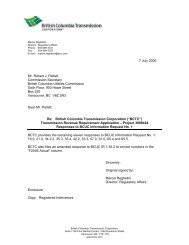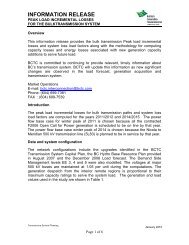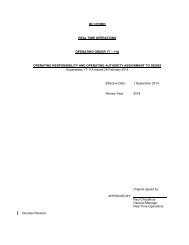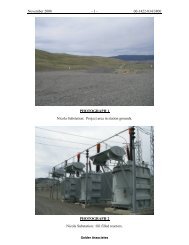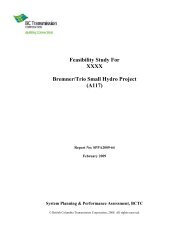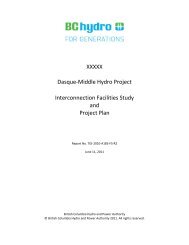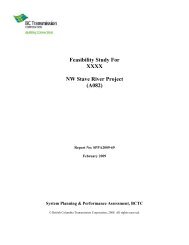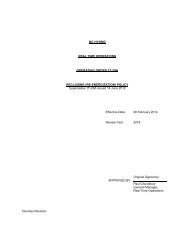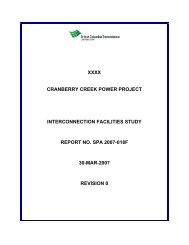Evidence on the Adequacy of First Nations Consultation - BC Hydro ...
Evidence on the Adequacy of First Nations Consultation - BC Hydro ...
Evidence on the Adequacy of First Nations Consultation - BC Hydro ...
You also want an ePaper? Increase the reach of your titles
YUMPU automatically turns print PDFs into web optimized ePapers that Google loves.
DRAFT REPORT: Rights and Title Interests in <strong>the</strong> Columbia Valley Transmissi<strong>on</strong> Project Area<br />
The first site that Thomps<strong>on</strong> chose for a post was <strong>on</strong> Lake Windermere, but when this site was<br />
found to be unsuitable, he travelled downstream to near where Toby Creek enters <strong>the</strong> Columbia<br />
River, near <strong>the</strong> present Invermere. Here Thomps<strong>on</strong> established “Kootanae House” and began<br />
trading with <strong>the</strong> “Kootanae” people. 61 This site is across <strong>the</strong> river from <strong>the</strong> present Shuswap<br />
Indian Reserve. Thomps<strong>on</strong> does not suggest that any Aboriginal people lived in <strong>the</strong> immediate<br />
envir<strong>on</strong>s <strong>of</strong> <strong>the</strong> new post, but people identified as “Kootenae” [Ktunaxa] were in <strong>the</strong> sou<strong>the</strong>rn<br />
Columbia Valley.<br />
Thomps<strong>on</strong> made several references to bands <strong>of</strong> Ktunaxa. On 28 July 1807, he referred to ano<strong>the</strong>r<br />
“small band <strong>of</strong> Kootanaes who are about a l<strong>on</strong>g day’s March <strong>of</strong>f.” 62 In August, he was visited by<br />
four tents <strong>of</strong> Kootanaes who had spent most <strong>of</strong> <strong>the</strong> summer “in <strong>the</strong> mountains am<strong>on</strong>g <strong>the</strong><br />
buffalo.” 63 Thomps<strong>on</strong> also sent by means <strong>of</strong> <strong>the</strong> Ktunaxa “a small Present <strong>of</strong> Tobacco to <strong>the</strong> Lake<br />
& Saleesh Indians.” As David Chance pointed out in his study, <strong>on</strong>ce Thomps<strong>on</strong> was in <strong>the</strong><br />
country he learned about “ano<strong>the</strong>r group to <strong>the</strong> southwest to whom <strong>the</strong>y applied <strong>the</strong> terms<br />
‘Lakes,’ ‘Arc Plattes,’and ‘Flatbows’.” 64 These terms refer to Ktunaxa bands, including <strong>the</strong> <strong>on</strong>e<br />
at <strong>the</strong> Columbia Lakes. 65 On 16 September, Thomps<strong>on</strong> reports that “12 Lake Indian Men with<br />
<strong>on</strong>e Woman arrived: <strong>the</strong>y have passed al<strong>on</strong>g <strong>the</strong> Kootanae River thro’ <strong>the</strong> Mountains.” 66 It is also<br />
Ktunaxa people to whom Thomps<strong>on</strong> refers when he writes <strong>on</strong> 27 August 1807, with respect to<br />
<strong>the</strong> Peigans’ c<strong>on</strong>cern with <strong>the</strong> Company’s interrupti<strong>on</strong> <strong>of</strong> <strong>the</strong>ir trade m<strong>on</strong>opoly:<br />
About 2 PM, 12 Peagan young Men & 2 Women arrived—<strong>the</strong>y are come<br />
to see how we are situated. I had expected <strong>the</strong>m l<strong>on</strong>g ago, & it must be<br />
<strong>the</strong>ir Policy to be highly displeased with us for being here, as we thus<br />
render all <strong>the</strong>se Indians independent <strong>of</strong> <strong>the</strong>m over whom from time<br />
almost immemorial <strong>the</strong>y have held in dependence or as enemies, &<br />
destroyed <strong>the</strong>m. They have it in <strong>the</strong>ir power to be very troublesome to us,<br />
& even to cut us <strong>of</strong>f... 67<br />
61 Glover 1962, pp. xci-xcii; Belyea 1994, pp. 55ff.<br />
62 Belyea 1994, page 57.<br />
63 Belyea 1994, page 59.<br />
64 The “Lakes” in this c<strong>on</strong>text are likely <strong>the</strong> Columbia Lakes people and <strong>the</strong> Flatbows or Arc Platte are <strong>the</strong><br />
“lower Kutenai” <strong>of</strong> <strong>the</strong> Kootenay River. See Chance 1981, page 7.<br />
65 The Columbia Lake Ktunaxa should not be c<strong>on</strong>fused with <strong>the</strong> “Lakes” or “Sinixt” (with various<br />
spellings) people <strong>of</strong> <strong>the</strong> Arrow Lakes who bel<strong>on</strong>g to a different ethnic group and speak an entirely different<br />
language. See Dorothy Kennedy and Randy Bouchard (1998). Nor<strong>the</strong>rn Okanagna, Lakes, and Colville. Handbook<br />
<strong>of</strong> North American Indians, Vol. 12, Plateau (ed. by Deward E. Walker Jr.). Smiths<strong>on</strong>ian Instituti<strong>on</strong>: Washingt<strong>on</strong><br />
D.C. Pp. 238-240. For a discussi<strong>on</strong> <strong>of</strong> Upper Ktunaxa bands, see secti<strong>on</strong> 2.3.1 <strong>of</strong> this present report.<br />
66 Belyea 1994, page 66.<br />
67 Belyea 1994, page 62.<br />
Bouchard & Kennedy Research C<strong>on</strong>sultants Page 13<br />
Page 16 <strong>of</strong> 200






